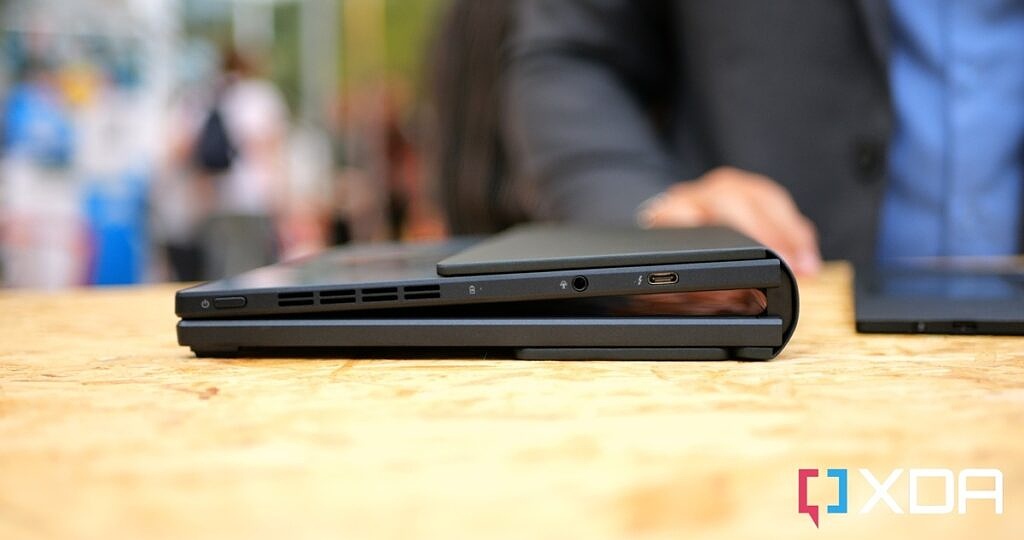
If you’ve ever heard the term “foldable laptop”, your instinctual reaction was probably to ask what laptops aren’t foldable. At least, that’s what mine was. However, in recent times we’ve seen the advent of foldable smartphones like the Samsung Galaxy Z Fold 4, and that same foldable display technology trickling into other mediums too, most notably laptops. A foldable laptop is one where the display folds, and there’s typically an external keyboard, too. We had some time to play with the Asus Zenbook 17 Fold OLED at this year’s IFA, and it’s a pretty cool device.
To be clear as well, the technology is pretty immature at this point in time. The display on this laptop was hard to see outdoors, and it obviously has a pretty unsightly gap when folded, too. To put the final nail in the coffin, it’s pretty expensive, coming in at $3,499. The technology has a long way to go before it can be recommended to most consumers, but I will say that what Asus was able to show us was impressive.

Asus Zenbook 17 Fold OLED: 17 inches of foldable goodness
The Asus Zenbook 17 Fold OLED (wow, what a name), comes in at 17.3-inches when unfolded, making it a bit of a behemoth when taken out on a table. When used with the keyboard attachment magnetically attached to the bottom half, the display comes in at a lot more reasonable 12.5-inches — fairly compact. The display is 2560 x 1920 when completely unfolded, and while I didn’t get exact specs, it’s not the brightest when used outside.
What was particularly interesting about this foldable laptop was how the company handles the hinge. While the Lenovo ThinkPad Fold X1 Gen 2 does not have a gap when folded, you can’t keep a keyboard inside of it. You need to remove it, then fold the laptop. Asus went with a different approach, though it’s more because of the fact that the company hasn’t figured out making a fold without a gap. When folded without the keyboard inside, there’s a gap, and when folded with the keyboard attached, it’s virtually indistinguishable from a normal laptop. You can fold it either way.
While at first, I detested the gap on the Zenbook, I actually like some of its usses. You can choose if you want to bring the keyboard and place it inside of it or not. On the Lenovo, you don’t get that choice, and I could definitely see myself getting annoyed by needing to carry a keyboard separately. It can magnetically attach to the outside, sure, but I can still see it getting dirty much easier by attaching to the outside of the device instead of the inside. I’m torn between both, and I actually think that I prefer the slightly immature technology of the Asus for this reason.
The design is a thought-out one, making it a pleasant laptop to use. The Asus Zenbook 17 Fold OLED comes in at 1.5kg (3.3lbs) of weight by itself, and 1.8kg (3.97lbs) with the keyboard. For context, the recently announced Huawei MateBook Pro comes in at 1.38kg — and that’s without a bunch of cool folding tech. The reason the Asus can be as light as it is (relatively speaking) is thanks to its magnesium alloy chassis, which is pretty common for thin and light laptops.

As well, there’s a glass panel on the outside with the etched Asus monogram, and a leather cover wraps around the hinge. The hinge that enables the foldable design was also designed to be as durable as possible, and Asus tested for 30,000 open-and-close cycles, which would be enough to last you five years, assuming you open the laptop 15 times a day.
Other features include two Thunderbolt 4 ports, a headphone jack (something its Lenovo counterpart does not have), quad speakers, an Intel Core i7-1250U, 16GB of RAM, 1TB of storage, 75 Wh of battery, and so much more. It’s a pricey machine that you can certainly get better specs in something for less, but keep in mind that whatever you go for won’t have such a massive display, complete with the portability of something smaller.
In other words, while the tech is young, the Asus Zenbook 17 Fold OLED isn’t a bad laptop. I could definitely see this kind of technology being useful for any professionals who travel a lot and would really benefit from a larger screen. It’s not quite at the level where I think everyone should have one, but this laptop convinced me that the day for that is approaching quicker than ever.
The post Asus Zenbook 17 Fold OLED Hands-On: Surprisingly good, even if expensive appeared first on XDA.


